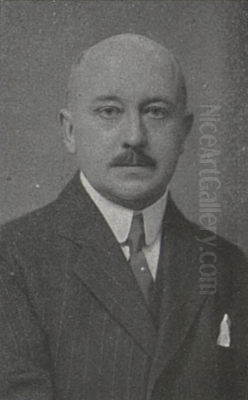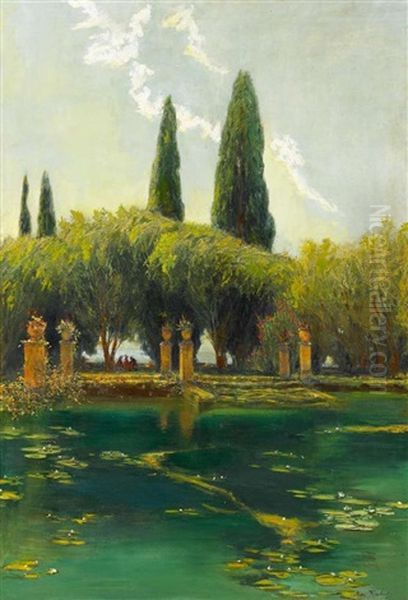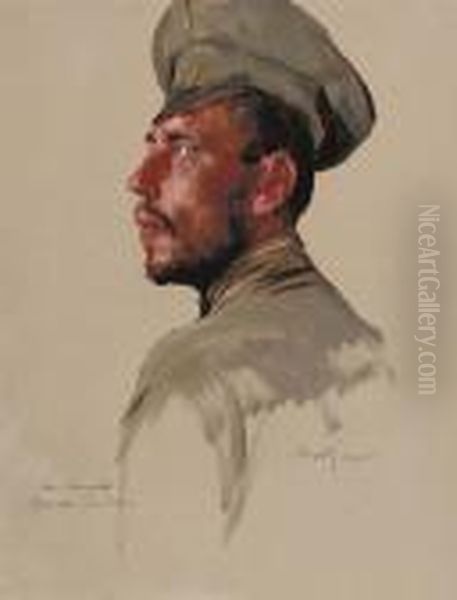Introduction: An Artist Defined by Travel

Max Friedrich Rabes (1868-1944) stands as a significant figure in German art history, particularly noted for his contributions to the Orientalist movement. Born in Samter (now Szamotuły, Poland), then part of the German Empire, Rabes developed a career that transcended national borders. His life was characterized by extensive travel across Europe, Africa, and Asia, experiences that profoundly shaped his artistic vision and subject matter. He became renowned for his vibrant depictions of landscapes, bustling street scenes, and intimate portrayals of life encountered during his journeys, establishing himself as a leading Orientalist painter in Berlin during the Wilhelmine era.
Early Life and Artistic Formation
Rabes's artistic journey began not in formal academies but through self-directed study of nature. This initial engagement with the natural world likely instilled in him a keen sense of observation and appreciation for light and atmosphere, qualities evident throughout his later work. His formal training commenced under the guidance of Paul Graeb, a respected Berlin-based painter known for his architectural views and landscapes. Graeb, son of the notable architectural painter Karl Graebner, provided Rabes with a solid foundation in perspective, composition, and the techniques required for landscape and architectural representation.
Seeking to broaden his skillset, Rabes was subsequently recommended to Paul Borgmann, a specialist in decorative painting. This phase of his education proved crucial, equipping him with the techniques necessary for large-scale decorative projects, including mural painting and theater set design. This dual training in both easel painting (landscape, architecture) and decorative arts provided Rabes with a versatile technical repertoire that would serve him well throughout his diverse career, allowing him to move fluidly between fine art creation and applied decorative commissions.
The Lure of the Orient and Early Journeys

Like many European artists of the 19th century, Rabes felt the powerful allure of the "Orient"—a term then used broadly to encompass North Africa, the Middle East, and parts of Asia. This fascination was fueled by a European desire for the exotic, the picturesque, and the perceived authenticity of cultures untouched by Western industrialization. Artists like Eugène Delacroix in France had earlier pioneered the artistic exploration of North Africa, followed by painters such as Jean-Léon Gérôme, whose detailed, almost photographic depictions of Middle Eastern life captivated audiences. Rabes became part of this continuing tradition.
In his early career, Rabes ingeniously funded his passion for travel and his burgeoning interest in Oriental subjects. He undertook practical commissions, painting stage sets for theaters and creating decorative murals for the residences and establishments of affluent patrons, including Italian merchants. These commissions not only provided financial support but also honed his skills in composition and large-format work. His early travels likely included extensive stays in Italy, a common destination for German artists seeking classical inspiration and picturesque landscapes, as evidenced by later works depicting Italian scenes.
Rise to Prominence and Imperial Patronage
Rabes's talent and his engaging depictions of foreign lands did not go unnoticed. He established himself in Berlin, becoming a prominent figure within the city's art scene, particularly among those artists specializing in Orientalist themes. His reputation grew significantly during the reign of Kaiser Wilhelm II, a period marked by Germany's increasing global ambitions and the Kaiser's personal interest in travel, naval power, and grand artistic representation. Artists who could capture the scope of German influence or the allure of distant lands often found favor.
A pivotal moment in Rabes's career came with his association with the German Emperor. He was invited to accompany Kaiser Wilhelm II on his significant state visit to the Ottoman Empire and the Levant in 1898. This journey took them to Constantinople (Istanbul), Jerusalem, Damascus, and other key locations in the Middle East. Traveling as part of the imperial entourage provided Rabes with unparalleled access and experiences, allowing him to sketch and gather impressions that would fuel his paintings for years to come. This imperial connection solidified his status and led to further recognition and commissions. He joined a circle of artists favored by the Kaiser, which included figures like the marine painter Carl Saltzmann, known for accompanying Wilhelm II on naval voyages. This contrasted with the more avant-garde artists of the Berlin Secession, such as Max Liebermann or Lovis Corinth, who pursued different aesthetic goals.
Artistic Style: Realism, Light, and Atmosphere

Max Rabes developed a distinctive artistic style that blended the academic realism inherited from his training with a heightened sensitivity to light and color, often characteristic of Impressionist influences, although he was not strictly an Impressionist painter. His Orientalist works are noted for their vibrant palettes, capturing the intense sunlight of the Middle East and North Africa, the deep shadows of narrow alleyways, and the rich textures of textiles, architecture, and market goods.
He possessed a strong ability to render architectural details accurately, a skill likely honed under Paul Graeb, which lent authenticity to his cityscapes and depictions of historical sites. However, his work often went beyond mere topographical accuracy. He infused his scenes with atmosphere and a sense of lived experience, populating his markets with figures engaged in daily activities and capturing the energy of urban life. While some Orientalist painters, like Gérôme or the Austrian-born Ludwig Deutsch, focused on meticulous detail and ethnographic accuracy (sometimes staged), Rabes often adopted a slightly looser, more painterly approach, particularly in his handling of light and crowds, giving his work a sense of immediacy.
His versatility extended to different media. While best known for his oil paintings, Rabes also worked in watercolor, created drawings and sketches during his travels, and produced colored prints, such as the mentioned Cairo Street print, making his exotic imagery accessible to a wider audience. His style adapted to the subject, ranging from detailed architectural studies to more atmospheric landscapes and lively genre scenes.
A World Observed: Themes and Subjects
Thematically, Rabes's oeuvre is dominated by his travels. The Orient, particularly Egypt and the Ottoman Empire, provided his most iconic subjects. He painted bustling marketplaces (souks) filled with merchants, shoppers, and animals, capturing the vibrant chaos and social interactions. Mosques, ancient ruins, and characteristic street scenes were recurring motifs, allowing him to explore architectural forms and the interplay of light and shadow in complex urban environments. The Souk in Egypt is a prime example of this genre, immersing the viewer in the sights and sounds of a Cairo market.
Beyond the Orient, Italy remained an important source of inspiration. His painting Stilles Wasser (Villa d'Este - Tivoli bei Rom) showcases his ability to capture the serene beauty of Italian landscapes and gardens. This work depicts the famous Renaissance gardens at Tivoli, known for their elaborate water features, reflecting a different facet of his interest in landscape and architecture, perhaps influenced by German Romantic traditions or artists known for Italian scenes like Oswald Achenbach.

His German subjects included landscapes and architectural views, such as the oil painting of Charlottenburg Palace in Berlin. He also painted genre scenes, like the work tentatively titled Große Wäsche am Flussufer (Large Laundry on the Riverbank), depicting everyday life, possibly observed during his European travels. Furthermore, his experiences during World War I led to a series of works reflecting the conflict, including studies made at the front and portraits like the Portrait of a Russian Soldier.
Notable Works: Capturing Moments in Time
Several specific works stand out in Max Rabes's extensive output, illustrating the breadth of his interests and the quality of his execution:
The Souk in Egypt / Oriental Scene in the Cairo Market: This subject, which he likely revisited in several variations, epitomizes his Orientalist focus. These paintings typically feature crowded market streets, detailed depictions of goods, varied figures in local attire, and a strong sense of atmospheric light filtering through covered alleyways or reflecting off sunlit walls. They showcase his skill in composing complex scenes and rendering diverse textures.
Stilles Wasser (Villa d'Este - Tivoli bei Rom): This painting demonstrates Rabes's mastery of landscape and his appreciation for historical European settings. It likely captures the reflective quality of the pools and fountains within the Villa d'Este gardens, emphasizing tranquility and the interplay of water, architecture, and foliage. It highlights his ability to shift mood and subject matter effectively.
Charlottenburg Palace: As a Berlin-based artist, Rabes also depicted local landmarks. This oil painting would have required careful architectural rendering combined with an understanding of landscape setting. It places him within a tradition of German artists documenting their national heritage and important architectural sites.
Große Wäsche am Flussufer (Large Laundry on the Riverbank): While the exact title and subject require confirmation (potentially mistranslated as Voting Women), a scene depicting women doing laundry by a river would be a typical European genre subject. Such a work would demonstrate his interest in everyday life and his ability to capture naturalistic scenes, possibly with an Impressionistic handling of light on water and figures in motion.
Portrait of a Russian Soldier: Stemming from his time near the front lines during World War I, this work represents a departure from his more picturesque travel scenes. It reflects the grim reality of war and showcases his skill in portraiture, likely aiming for psychological depth alongside physical likeness.
Cairo Street (Color Print): The existence of prints like this indicates Rabes's engagement with reproductive media, allowing his popular Orientalist imagery to reach a broader public beyond the collectors of unique oil paintings.
Decorative Arts and Architectural Commissions
Rabes's training under the decorative painter Paul Borgmann found practical application throughout his career. He was frequently commissioned for large-scale decorative projects, integrating his artistic vision into architectural spaces. These commissions demonstrate his versatility and his ability to work collaboratively with architects and patrons.
Notable examples include the murals for the canteen of a castle in Leipzig and oil paintings for a villa in Iserlohn (completed around 1901). One of his most significant decorative works was the ceiling painting for the Stadttheater (City Theater) in Breslau (now Wrocław, Poland), completed in 1906. Creating a theater ceiling required considerable skill in perspective (specifically, foreshortening figures and architecture to be viewed from below) and the ability to conceive a grand, unified composition suitable for a public space. These projects placed him in the lineage of artists who contributed to the Gesamtkunstwerk (total work of art) ideal, where painting, architecture, and interior design were harmoniously combined. His work in this field can be seen as part of a broader European trend in the late 19th and early 20th centuries, where artists like Hans Makart in Vienna also undertook large-scale decorative schemes for public and private buildings.
World War I and Later Career
The outbreak of World War I interrupted the relatively stable world in which Rabes had built his career. Like many artists of his generation, he engaged directly with the conflict. In 1915, he traveled to the war zone in East Prussia for study purposes. Later, he served near the Belgian front and experienced the brutal realities of trench warfare, including participation in the Battle of Verdun in February 1917.
These experiences inevitably found expression in his art. He produced sketches and paintings depicting scenes from the front, soldiers, and the landscapes scarred by war. These works offer a stark contrast to his often idyllic or exotic pre-war paintings. The Portrait of a Russian Soldier is one documented example from this period. His war art provides valuable historical documentation and insight into the artist's response to the cataclysm that reshaped Europe.
Despite the upheavals of war and the subsequent changes in the art world with the rise of modernism, Rabes continued to enjoy considerable respect. His established reputation, particularly his association with the pre-war imperial era and his mastery of traditional techniques, ensured his continued recognition. He received numerous honors and medals throughout his life. Significantly, he was appointed a Professor at the prestigious Berlin University of the Arts (Hochschule für Bildende Künste) and was also awarded an honorary doctorate, acknowledging his contributions to German art and his standing within the academic art establishment. He continued to paint and remained active in Berlin's art circles until his death in Vienna in 1944.
Contemporaries and Artistic Context
To fully appreciate Max Friedrich Rabes's position, it's helpful to view him within the context of his contemporaries and the broader art movements of his time. He operated during a period of significant artistic change in Germany and Europe.
In Germany, the late 19th and early 20th centuries saw the dominance of academic realism and historicism, often favored by official institutions and patrons like Kaiser Wilhelm II. Anton von Werner, known for his large-scale depictions of Prussian history, exemplified this official taste. Rabes, with his technical skill and often grand subjects (especially in decorative work), fit comfortably within this more established art world, particularly through his imperial connections alongside artists like Carl Saltzmann.
However, this was also the era of the Berlin Secession, founded in 1898 as a reaction against the conservative establishment. Leading figures like Max Liebermann, Lovis Corinth, and Max Slevogt championed German Impressionism and later Expressionism, pushing artistic boundaries. Rabes was not part of this avant-garde movement; his style remained more rooted in realism and the specific conventions of Orientalist painting.
Internationally, Rabes belonged to the later generation of Orientalist painters. While earlier figures like Delacroix explored the theme with Romantic fervor, and Gérôme brought a highly polished academic finish, Rabes's generation often incorporated lighter palettes and looser brushwork, reflecting the pervasive influence of Impressionism, even if not fully adopting its principles. He can be compared to other successful Orientalists of the period, such as Ludwig Deutsch and Rudolf Ernst, who were also known for their detailed and popular depictions of Middle Eastern scenes, or Gustav Bauernfeind, another German Orientalist known for his architectural views of Jerusalem and Damascus. His Italian landscapes connect him to a long tradition of Northern European artists traveling south, following in the footsteps of figures like Oswald Achenbach. His training links him directly to Paul Graeb and Paul Borgmann, representing the lineage of Berlin's architectural and decorative painting traditions.
Legacy and Influence
Max Friedrich Rabes left behind a substantial body of work characterized by skilled draftsmanship, a vibrant sense of color, and a deep engagement with the diverse cultures and landscapes he encountered during his extensive travels. As a prominent German Orientalist, he played a significant role in shaping and satisfying the European public's appetite for images of the exotic East. His paintings offered glimpses into faraway lands, rendered with an appealing blend of realism and atmospheric sensitivity.
His association with Kaiser Wilhelm II and his numerous official and private commissions underscore his success and acceptance within the art establishment of his time. His contributions to decorative painting, particularly large-scale projects like the Breslau theater ceiling, highlight his versatility and technical mastery beyond easel painting.
While the Orientalist genre has faced critical re-evaluation in post-colonial discourse for sometimes perpetuating stereotypes, Rabes's work remains historically important as a reflection of European perspectives and artistic interests of the late 19th and early 20th centuries. His paintings continue to be sought after in the art market, valued for their aesthetic qualities, historical context, and evocative depictions of a world captured through the eyes of a dedicated traveling artist. He remains a key representative of the Berlin school of Orientalist painting and an artist whose life was as adventurous as his canvases were colorful.
Conclusion: Chronicler of Distant Worlds
Max Friedrich Rabes navigated the transition from the 19th to the 20th century as an artist deeply engaged with the world around him, both near and far. His legacy is primarily tied to his role as a German Orientalist painter, one whose extensive travels provided the raw material for a lifetime of artistic creation. From the sun-drenched markets of Cairo to the serene gardens of Italy and the battlefields of World War I, Rabes observed and recorded with a skilled hand and a keen eye for detail and atmosphere. His ability to secure imperial patronage and execute major decorative commissions speaks to his professional success and adaptability. Though perhaps less revolutionary than some of his avant-garde contemporaries, Rabes created a rich and enduring body of work that continues to offer valuable insights into the artistic tastes and global outlook of his era.